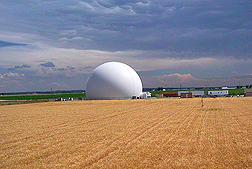Washington, DC, USA
August 23, 2012
 Reducing tillage for some Central Great Plains crops could help conserve water and reduce losses caused by climate change, according to studies at the U.S. Department of Agriculture (USDA).
Reducing tillage for some Central Great Plains crops could help conserve water and reduce losses caused by climate change, according to studies at the U.S. Department of Agriculture (USDA).
Research leader Laj Ahuja and others at the Agricultural Research Service (ARS) Agricultural Systems Research Unit at Fort Collins, Colo., superimposed climate projections onto 15 to 17 years of field data to see how future crop yields might be affected. ARS is USDA's chief intramural scientific research agency, and this work supports the USDA priority of responding to climate change.
The field data was collected at the ARS Central Great Plains Research Station in Akron, Colo. The projections included an increase in equivalent atmospheric carbon dioxide (CO2) levels from 380 parts per million by volume (ppmv) in 2005 to 550 ppmv in 2050. The projections also included a 5-degree Fahrenheit increase in summer temperatures in Colorado from 2005 to 2050. The ARS scientists used these projections to calculate a linear increase of CO2 and temperature from 2050 to 2100.
Ahuja's team used the Root Zone Water Quality Model (version 2) for crop rotations of wheat-fallow, wheat-corn-fallow, and wheat-corn-millet to see how yields might be affected in the future. They simulated different combinations of three climate change projections: rising CO2 levels, rising temperatures, and a shift in precipitation from late spring and summer to fall and winter. They ran the model with the projected climate for each of the 15 to 17 years of field crop data for each cropping system.
When the researchers used all three climate factors to generate yield projections from 2005 to 2100, the yield estimates for the three cropping systems dropped over time. Declines in corn and millet yields were more significant than declines in wheat yields.
Ahuja also simulated earlier planting dates and no-till management to see if either change reduced yield losses, but only the no-till option helped. In the wheat-fallow rotation with no tillage, wheat yields were higher than with conventional tillage through 2075. But by 2100, when summer temperatures had increased by 8 degrees F, even the no-till yield advantage was lost.
The results from this work were published inClimatic Change in 2012.
Read more about these studies in the August 2012 issue of Agricultural Research magazine.
Photo: This dome is a weather facility at Greeley, Colorado, one of many stations that gather multiple years of climate data used in combination with a model to project future crop yields in response to various climate changes. Photo by Tim Green.
Los rendimientos de cultivos y el cambio climático global
Reducir la labranza de algunos cultivos en las Grandes Llanuras Centrales podría ayudar a conservar agua y reducir las pérdidas de rendimientos causadas por el cambio climático global, según los resultados de estudios por científicos del Servicio de Investigación Agrícola (ARS).
Líder de investigación Laj Ahuja y sus colegas en la Unidad de Investigación de Sistemas de Agricultura mantenida por el ARS en Fort Collins, Colorado, combinaron datos sobre el clima del futuro con datos recopilados de campos por 15 a 17 años para determinar los efectos posibles del cambio climático en los rendimientos de cultivos. ARS es la agencia principal de investigaciones científicas del Departamento de Agricultura de EE.UU. (USDA por sus siglas en inglés), y esta investigación apoya la prioridad del USDA de responder al cambio climático.
Los datos de campo se recopilaron en la Estación de Investigación de las Grandes Llanuras Centrales mantenida por el ARS en Akron, Colorado. Las proyecciones incluyeron un aumento en los niveles del dióxido de carbono (CO2) atmosférico de 380 partes por millón de volumen (ppmv por sus siglas en inglés) en el 2005 a 550 ppmv en el 2050. Las proyecciones también incluyeron un aumento de 5 grados Fahrenheit en las temperaturas de verano en Colorado del 2005 al 2050. Los científicos del ARS usaron estas proyecciones para calcular un aumento lineal del CO2 y la temperatura del 2050 al 2100.
El grupo dirigido por Ahuja usó el Modelo de Calidad de Agua de la Zona de Raíces (versión 2) con rotaciones de cultivos incluyendo trigo en combinación con el campo en barbecho; trigo y maíz en combinación con el campo en barbecho; y una rotación de trigo, maíz y mijo. Los investigadores simularon diferentes combinaciones de tres proyecciones del cambio climático: niveles crecientes de CO2; aumentos en temperaturas; y un cambio en las precipitaciones de la primavera y el verano al otoño y el invierno. Utilizaron su modelo con el clima proyectado para cada uno de los 15 a 17 años de datos de cultivos de campo en cada rotación de cultivos.
Cuando los investigadores usaron todos los factores de clima para generar las proyecciones de rendimientos del 2005 al 2100, las estimaciones de rendimientos con los tres sistemas de rotaciones redujeron con el tiempo. Las reducciones fueron más significativas en el maíz y el mijo comparadas con las en el trigo.
Ahuja también simuló fechas de plantación más tempranas y el uso de la cero labranza para determinaron si cualquiera de estos dos factores redujo las pérdidas de rendimientos, pero solamente el uso de la cero labranza tuvo un impacto positivo. En la rotación del trigo y el campo en barbecho combinada con la cero labranza, los rendimientos del trigo fueron más altos que los con la labranza convencional por 2075. Pero por el 2100, cuando las temperaturas del verano han aumentado por 8 grados F, aún la ventaja de la cero labranza se perdió.
Los resultados de esta investigación fueron publicados en la revista 'Climatic Change' (Cambio Climático) en el 2012.
Lea más sobre esta investigación en la revista 'Agricultural Research' de agosto del 2012.